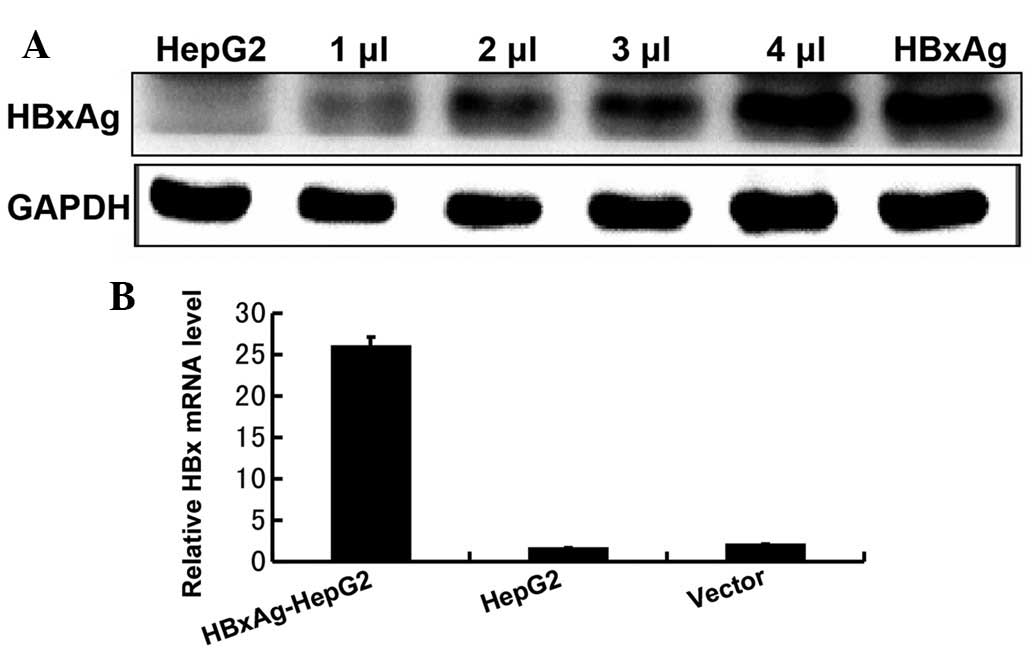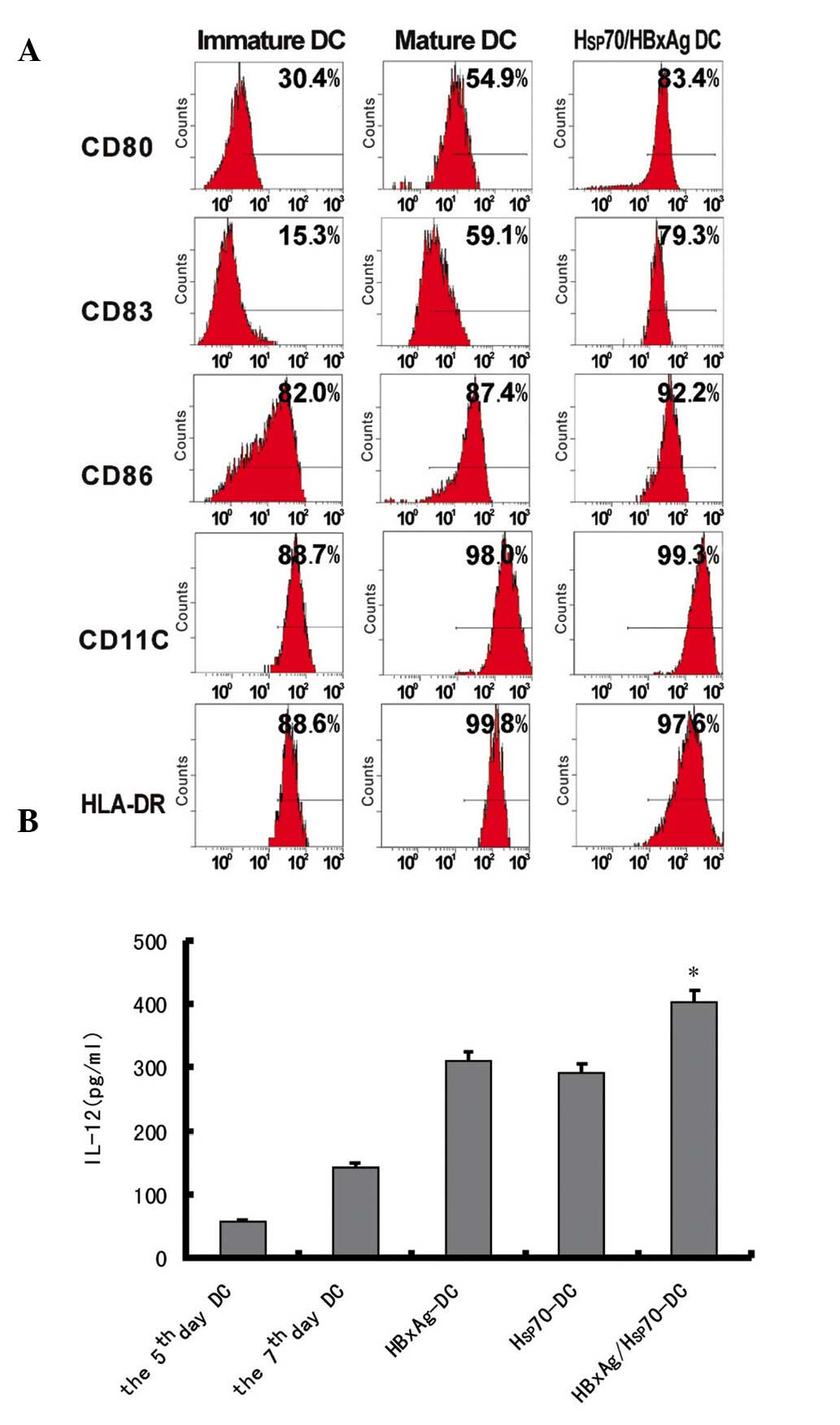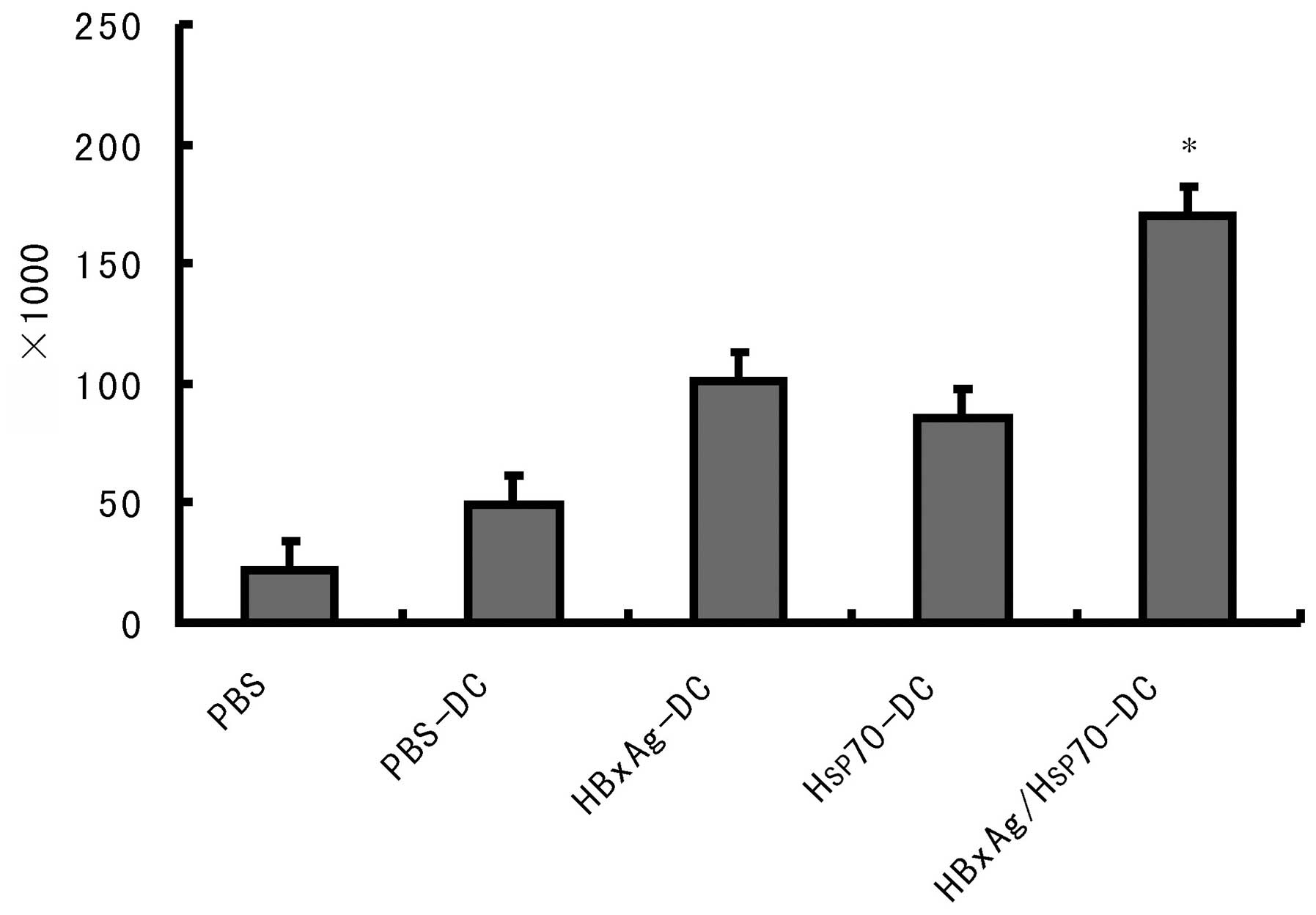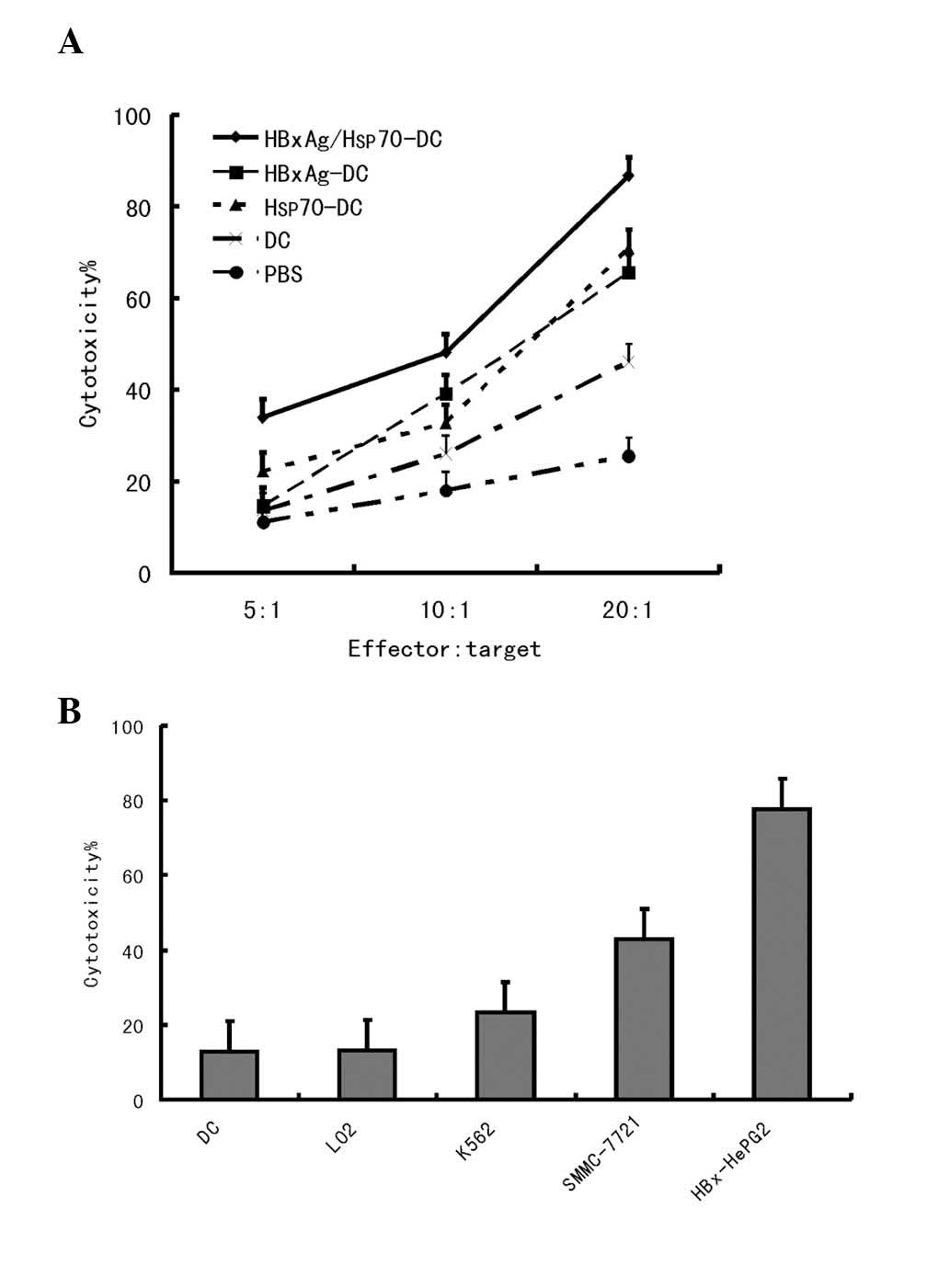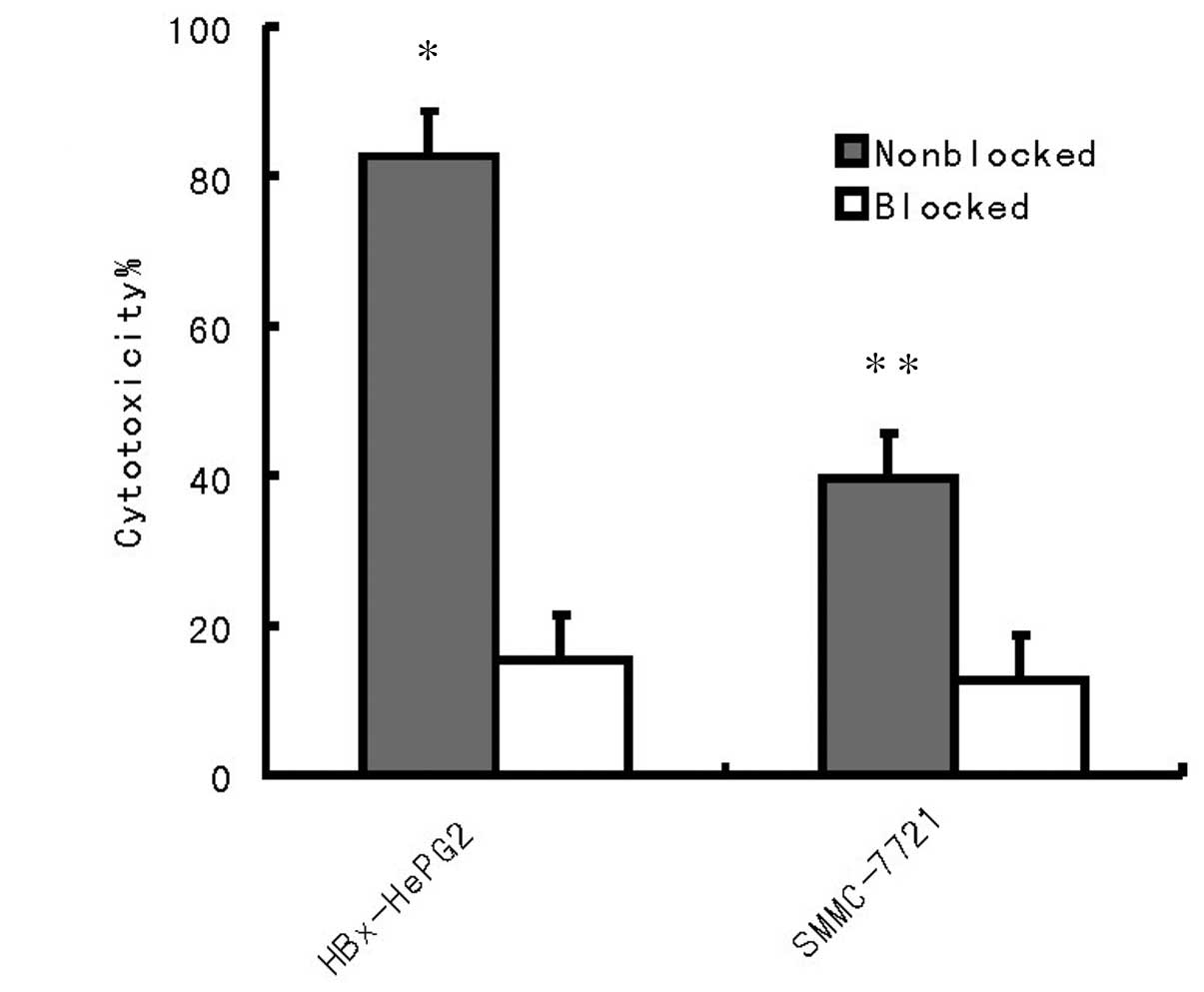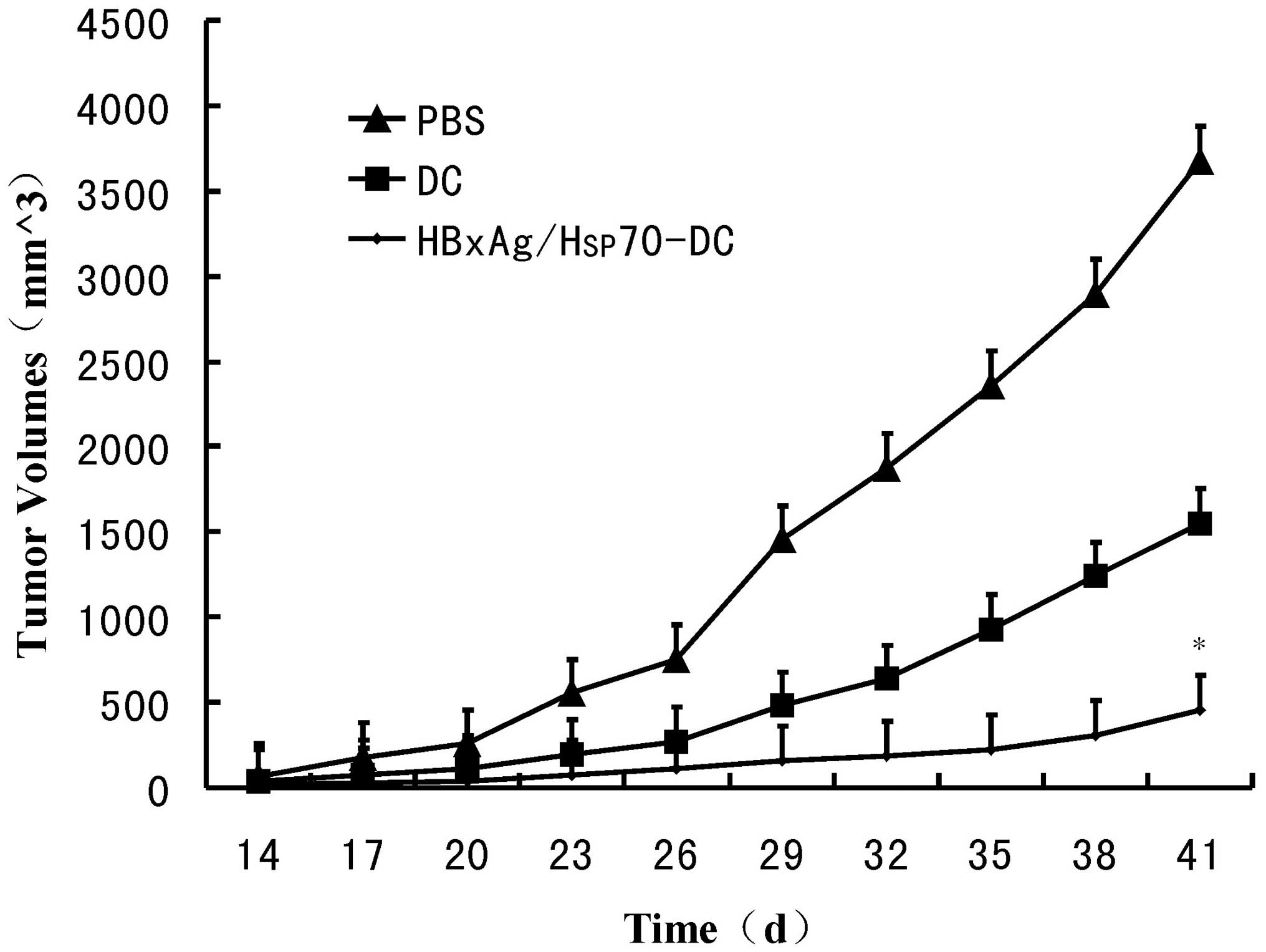Dendritic cells pulsed with Hsp70 and HBxAg induce specific antitumor immune responses in hepatitis B virus‑associated hepatocellular carcinoma
- Authors:
- Published online on: December 7, 2015 https://doi.org/10.3892/mmr.2015.4654
- Pages: 1077-1082
-
Copyright: © Wang et al. This is an open access article distributed under the terms of Creative Commons Attribution License.
Abstract
Introduction
Hepatocellular carcinoma (HCC) causes high rates of mortality worldwide and is increasing in incidence (1). Epidemiological investigation demonstrates that the incidence of HCC is associated with the hepatitis B virus (HBV) x antigen (HBxAg) (2). The risk of developing HCC in HBxAg-positive individuals is higher compared with that in the HBxAg-negative populations (1,3). Currently, the predominant clinical treatment for HCC is surgical resection and liver transplantation, however, the majority of patients lose surgical opportunity (4). Therefore, identifying a safe and efficient therapeutic strategy for HCC is of great global significance.
Immunotherapy, which stimulates tumor-specific immune responses has become one of the most promising emerging treatments (5). Previous studies have demonstrated the development of dendritic cell (DC) vaccination. DCs exhibit properties associated with innate and adaptive protective immune responses, induce tumor-specific effector T cells, and specifically decrease tumor mass and tumor relapse (6–8).
Heat shock proteins (HSPs), also termed stress proteins, are essential in the regulation of protein synthesis and vesicular trafficking, and have been demonstrated as potent adjuvants in cancer immunotherapy (9). Certain previous results suggest that the preparation of HSPs from various types of tumor can elicit different cytotoxic antitumor immune responses, and induce the development of distant metastases (10). HSPs can also bind and present tumor-associated antigens to antigen-presenting cells through major histocompatibility complex (MHC) class I and II molecules, leading to the activation of antitumor CD8+ and CD4+ T cells (11).
However, whether using DCs co-pulsed with Hsp70/HBxAg complexes activates the cytotoxic antitumor immunoresponse in the HCC cells of HBxAg-positive individuals remains to be elucidated. The present study used DCs pulsed with Hsp70-peptide and/or HBxAg complexes to activate autologous T cells. The present study aimed to use pulsed DCs to develop a novel therapeutic strategy for the treatment of HCC, and also strived to provide a novel tumor vaccine approach against human HCC.
Materials and methods
Cell lines and regents
The human LO2 hepatic cell line, human SMMC-7721 HCC cell line and human K562 natural killer cell sensitive cell line were purchased from the American Type Culture Collection (Rockville, MD, USA). The human HepG2 HCC cell line (HBxAg+), was provided by Professor Xiaodong Zhang (College of Life Sciences, Nankai University, Tianjin, China). The cells were cultured in RPMI-1640 medium, containing 10% fetal bovine serum (HyClone Laboratories Inc., Logan, UT, USA), 100 U/ml penicillin G and 100 µg/ml streptomycin (Gibco Life Technologies, Carlsbad, CA, USA), at 37°C in a humidified atmosphere of 95% air and 5% CO2. The present study was approved ethics committee of the Second Affiliated Hospital of Soochow University (Suzhou, China).
HBxAg was purchased from MyBioSource, Inc. (San Diego, CA, USA). Hsp70 peptide was purified by Enzo Life Sciences, Inc. (Farmingdale, NY, USA).
Preparation of DCs
DCs were generated, as described previously (12). Briefly, peripheral blood mononuclear cells (PBMCs) were isolated from healthy donors (Suzhou Blood Center, Jiangsu, China), using Ficoll-Hypaque (TBD Science, Tianjin, China) density gradient centrifugation and cultured in RPMI-1640 medium, containing 10% FBS for 2 h. The non-adherent cells were removed for the isolation of T cells and the adherent cells were cultured for 7 days in RPMI-1640 medium, containing 10% FCS, 100 ng/ml human granulocyte macrophage colony-stimulating factor (GM-CSF; Amoytop, Xiamen, China) and 10 ng/ml human interleukin (IL)-4 (Amoytop). The culture medium and cytokines were refreshed every 2 days. DCs were harvested on the 7th day.
Flow cytometric assay
The DCs were pulsed with Hsp70-peptide (ProSpec, Rehovot, Israel) and/or HBxAg (ProSpec) at 37°C for 4 h, and were cultured for another 48 h. The DCs were washed with cold phosphate-buffered saline (PBS), and incubated with murine monoclonal anti-human HLA-DR (cat. no. 560943), CD11c (cat. no. 560999), CD80 (cat. no. 560926), CD86 (cat. no. 560958) and CD83 (cat. no. 560929; BD Pharmingen, San Diego, CA, USA) for 1 h in ice. Following incubation, the cells were washed with cold PBS and were incubated with fluorescein isothiocyanate-conjugated with goat anti-mouse IgG (BD Pharmingen) for 30 min on ice. The cells were subsequently washed with cold PBS and fixed with 2% paraformaldehyde (Sigma-Aldrich, St. Louis, MO, USA). The fluorescence intensity was analyzed using an Epics XL FACS Calibur (Beckman Coulter, Inc., Fullerton, CA, USA) and EXPO32 ADC CellQuest analysis software (Beckman Coulter, Inc.) (13).
IL-12 release enzyme-linked assay
Following treatment with different antigens, DCs were cultured in 6-well plates for 24 h. Cytokine release in the supernatants was subsequently assessed by an ELISA using an IL-12 ELISA detection kit (R&D Systems, Shanghai, China).
Mixed lymphocyte reaction
The mixed lymphocyte reaction was performed, as described previously (14). Briefly, 1×105 CD4+ T cells were mixed with antigen-pulsed DCs and normal control DCs (R/S ratio, 10:1, 20:1 and 50:1). They were seeded into flat-bottomed 96-well plates in 200 ml RPMI-1640 medium, containing 40 ng/ml IL-2, and were cultured at 37°C for 5 days. The cells were harvested onto glass fiber filters with a 96-well plate cell harvester (PLT 96WL; Corning Incorporated, Corning, NY, USA). Cell-associated radioactivity was determined using a cell counting kit-8 assay kit (Shanghai Qcbio Science & Technologies Co., Ltd., Shanghai, China). The results of triplicate assays are expressed as the mean counts per minute ± standard deviation.
Cytotoxicity assay
The autologous CD8+ T cells were incubated with stimulators (PBS-DCs, Hsp70-DCs, HBxAg and Hsp70/HBxAg-DCs) at a ratio of 20:1 in 96-well culture plates in RPMI-1640 medium, containing 40 ng/ml IL-2 for 5 days at 37°C with 5% CO2. The cytotoxicity analysis was performed using a lactate dehydrogenase (LDH) release assay. Briefly, the effector T cells were harvested and incubated with HepG2 cells at ratios of 5:1, 10:1 and 20:1 in 96-microwell plates at 37°C and 5% CO2 for 4 h. The plates were subsequently centrifuged for 5 min at 250 × g, at room temperature. The supernatants from each well (100 µl) were transferred into 96-well flat-bottomed microwell plates and 100 ml LDH substrate mixture was added. Following incubation for 15 min, the absorbance was measured at 490 nm on an ELISA 550 Microplate reader (Bio-Rad Laboratories, Inc. Hercules, CA, USA). The CTL-mediated cytotoxicity was calculated using the following formula: Cytotoxicity-[1-(effector target-effector)/target] × 100.
Different cell types, HepG2 (HLA-A2+/HBxAg+), SMMC-7721 (HLA-A2+/HBxAg−), K562 (HLA-A2−/HBxAg−) and LO2-DCs human hepatic cells, were used as target cells. The cytotoxicity was subsequently detected by the LDH assay kit (Promega Corporation, Madison, WI, USA).
Reverse transcription-quantitative polymerase chain reaction (RT-qPCR)
The total RNA was extracted using TRIzol reagent (Invitrogen Life Technologies, Carlsbad, CA, USA). The total RNA (2.5 µg) was reverse transcribed using a Superscript™ III kit (Invitrogen Life Technologies), according to the manufacturer's instructions. PCR amplification was performed in a 50 µl PCR reaction mixture, containing 10 mM Tris-HCl (pH 8.3), 50 mM KCl, 2 mM MgCl2, 20 pmol each primer set, 2 units Taq DNA polymerase (Beyotime Institute of Biotechnology, Jiangsu, China), 0.2 mM dNTPs and 2 ml cDNA. PCR was performed for 40 cycles at 95°C for 10 min, 95°C for 15 sec and 60°C for 1 min in a 7900HT Fast Real-Time PCR System (ABI, Palo Alto, CA, USA), and analysis of the dissociation curve was performed at 95°C for 15 sec, 60°C for 1 min, 95°C for 15 sec and 60°C for 15 sec. The nucleotide sequences of the oligonucleotide primers for HBxAg were as follows: Forward: 5′-ACCGACCTTGAGGCCTACTT-3′ and reverse: 5′-GCTTGGCAGAGGTGAAAAAG-3′ (Sangon Biotech Co., Ltd., Shanghai, China).
Immunoblot analysis
The total cellular proteins were extracted by lysing cells in a sodium dodecyl sulfate (SDS) sample buffer, containing 62.5 mM Tris-HCl (pH 6.8), 2% SDS, 1 mM phenylmethylsulfonyl fluoride, 10 mg/ml pepstatin, 12.5 mg/ml leupeptin, 2 mg/ml aprotinin, 1 mM sodium orthovanadate and 1 mM sodium molybdate. The method of cell extraction for western blotting was performed, as described previously (15). The HBxAg used for immunoblot analysis was purchased from MyBioSource, Inc. (San Diego, CA, USA).
Adaptive immunotherapy in the xenograft model of nude mice
Female severe combined immunodeficiency (SCID) mice (n=10; age, 4 weeks; weight, 9.7±0.51 g) were purchased from (Shanghai Laboratory Animal Center, Shanghai, China). The SCID mice were inoculated subcutaneously with 7.5×106 HepG2 tumor cells in 150 ml Matrigel (Becton Dickinson, Bedford, MD, USA) and 50 ml sterile PBS. Following tumor inoculation for 7 days, the SCID mice were randomized into three groups and treated with T cells (2.5×106) stimulated with the following: i) Fusion cells (cells expressing HBxAg and Hsp70); ii) DCs; or iii) PBS. The T cells were injected into tumors every 4 days and the tumors were measured each time using vernier calipers. Tumor volume was calculated as follows: 1/2 × (length × width2).
Statistical analysis
The experiments and in vitro assays were performed at least three times. The differences between the mean values were assessed by Student's t-test. Statistical analysis was conducted using Prism 4 (GraphPad Software, Inc., La Jolla, CA, USA). P<0.05 was considered to indicate a statistically significant difference.
Results
HepG2 cells stably express HBxAg
In order to determine the role of HbxAg in human hepatic cell lines, it was first confirmed that the HepG2 cell line stably expressed the HbxAg following transfection. Western blotting and RT-qPCR were used to detect the expression levels of HbxAg in the HepG2 cells. As shown in Fig. 1, the results revealed that the HepG2 cell line exhibited a high expression level of HbxAg, following transfection.
Maturation of human DCs pulsed with different antigen complexes
To investigate the effects of antigen complexes derived from HepG2 cells on DCs, immature DCs were generated by culturing human PBMCs in the presence of human GM-CSF and IL-4 for 7 days. The immature DCs were incubated with antigen complexes at 37°C and were subsequently cultured for 48 h. The expression levels of HLA-DR, CD86, CD11c, CD80 and CD83 were determined by flow cytometry. The expression levels of HLA-DR, CD86 co-stimulation molecule, CD83 maturation marker, CD11c and CD80 were significantly upregulated (Fig. 2A). These results indicated that antigen complexes induced the maturation of DCs, suggesting that antigen complexes effectively activated DCs.
Cytokine release of DCs pulsed with different antigens
The IL-12 release in the supernatants of DCs either pulsed or non-pulsed with different antigens was assessed by ELISA. The results revealed that the levels of IL-12 were significantly upregulated following infection for 24 h. However, when the DCs were pulsed with Hsp70/HBxAg, the level of IL-12 was higher compared with that of DCs pulsed with PBS, HBxAg and Hsp70 (Fig. 2B). The results demonstrated that the antigens activated CD4+ and CD8+ T cells.
Induction of specific CTLs against HepG2 by DCs pulsed with Hsp70/HBxAg complexes
The functional capability of the CTLs responding to antigen-pulsed DCs was assessed by determining whether it specifically killed tumor cells. CD8+ T cells were plated into 96-well plates in a medium containing IL-2. DCs were added at a 1:20 ratio and cocultured at 37°C in 5% CO2. As shown in Fig. 3, the DCs pulsed with antigens significantly induced T-cell proliferation. The highest level of T-cell proliferation was observed when the DCs were co-pulsed with HBxAg/Hsp70.
The cytotoxic activity against HCC cells was also assessed. Target cells were composed of HepG2 (HLA-A2+/HBxAg+), SMMC-7721 (HLA-A2+/HBxAg−), K562 (HLA-A2−/HBxAg−) and LO2 cells. A small number of CTLs were induced by the HBxAg-DC vaccine; however, no significant CTL induction was observed by PBS-DCs. The results indicated that Hsp70/HBxAg-DCs specifically induced high CTL activity against HBxAg-expressing HepG2 cells. In the Hsp70/HBxAg-positive group, the CTL response was markedly higher compared with that observed in the Hsp70/HBxAg-negative group, indicating that the CTL response is antigen dependent (Figs. 3 and 4).
To further confirm whether the cytotoxicity in tumors is independent of the MHC class I immunoresponse, two HCC cell lines HepG2 and SMMC-7721 were used for detection (Fig. 5). The results revealed that the cytotoxicity against HepG2 and SMMC-7721 cells was independent of MHC class I.
Establishment of Hsp70/HBxAg-DCs in the SCID mouse model
To determine the efficacy of CTLs stimulated by Hsp70/HBxAg-DCs, SCID mice were inoculated with HepG2 cells. Following inoculation for 7 days, the mice were treated with CTLs induced by fusion cells, DCs or PBS. Following treatment for 5 weeks, the fusion cell (Hsp70/HBxAg-DCs)-stimulated T cells significantly reduced the tumor volumes (Fig. 6). The results indicated the possible therapeutic potency of T cells stimulated by Hsp70/HBxAg-DCs.
Discussion
DCs are efficient antigen-presenting stimulators of B and T lymphocytes, which have potent immunostimulatory properties (16,17). Several immunotherapies regulate DCs to stimulate the immune response (18). Previous studies demonstrated that DC-based vaccine therapy effectively stimulates T-cell immunity and kills tumor cell lines, including malignant melanoma (19), breast cancer (20) and ovarian cancer (21) cells.
A previous study suggested that HSPs, including Hsp70 and Hsp90, are potent tumor-antigen sources for pulsing DCs to activate macrophages and release specific and non-specific effecter molecules, which can increase the effect of the macrophages (22). Inducible Hsp70 may function as a crosslink between the innate and adaptive immune response (23,24).
HBxAg is associated with several advanced liver diseases, and HBxAg and other etiological factors have been implicated in hepatocarcinogenesis (25). HBxAg can increase the risk of HCC in patients with chronic HBV infection. Previous studies have revealed that a vaccination composed of particulate hepatitis B antigen induces a specific immune response and significant antitumor effects in vivo (26) and in vitro (27).
However, whether the Hsp70/HBxAg complex enhanced the immune response in the HepG2 cells expressed by HBxAg remains to be elucidated. Therefore, the present study predominantly used HepG2 (HBxAg+) (Fig. 1A and B) and SMMC-7721 (HBxAg−) cells to confirm this hypothesis. The functional maturation and proliferation of DCs is a critical step in the stimulation of tumor-specific CTLs (28). In addition, the results consistently indicated the detection of different markers, such as the CD86 costimulatory molecule, CD83 maturation marker, and other markers including CD80 and CD11c (Fig. 2A), thereby demonstrating that different antigens induce the maturation of allogeneic DCs by upregulating.
CD4+ T cells have an important role in the induction and maintenance of the CTL response (29). The results from the present study demonstrated that DCs pulsed with Hsp70 complexes stimulated CD4+ T cell proliferation and unpulsed DCs exhibited few stimulatory effects. DCs pulsed with Hsp70/HBxAg also activated a more marked increase in CD4+ T cell proliferation compared with the DCs pulsed with only Hsp70 or HBxAg alone (Fig. 2B).
A previous study revealed that tumor cytotoxicity is mediated by lymphocytes, notably by CTLs (30). Therefore, in the process of tumor immunotherapy, activating tumor-specific CTLs to kill tumor cells is considered an important event (31). The present study revealed that Hsp70-DCs and HBxAg-DCs were able to induce CTL activity against HCC cells with high efficiency, consistent with this previous observation (Fig. 3). However, the data demonstrated that Hsp70- or HBxAg-DCs elicited limited CTL responses against the HCC tumor cell. Notably, after they were co-pulsed with Hsp70 and HBxAg, the Hsp70/HBxAg-DCs were able to stimulate CD4+ T cells, which proliferated more effectively compared with those activated by DCs pulsed with HBxAg or Hsp70 alone (Fig. 3).
To further confirm that CTLs killed the HepG2 cells, and to define the specificity of the CTLs generated by the coculture of T cells with autologous DCs pulsed with Hsp70-peptide and/or HBxAg complexes, the cytotoxicity of the T-cell against HepG2 (HLA-A2+/HBxAg+), SMMC-7721 (HLA-A2+/HBxAg−) cells and another human cancer cell, K562 (HLA-A2−/HBxAg−), was compared. Notably, the results demonstrated that the cytotoxicity against HepG2 and SMMC-7721 cells was caused by the presence of CTLs, not by natural killer cells. The reason is that the cytotoxicity against the natural killer cell-sensitive cell line, K562, is slightly lower compared with SMMC-7721 and HepG2 cells. K562 cells are HLA-A2−/HbxAg−, SMMC-7721 cells are HLA-A2+/HBxAg− and HepG2 cells are HLA-A2+/HbxAg+. Thus, in conclusion cytotoxicity occurred in an antigen-specific manner (Fig. 4B).
Numerous co-stimulatory molecules, including CD80 or CD86, can induce tumor-specific T lymphocytes. The cytotoxicity induced by the antigens can be blocked by anti-MHC class I antibody (12). The present study used two HCC cell lines, HepG2 and SMMC-7721, for detection. As shown in Fig. 5, pre-incubation of the HepG2 and SMMC-7721 cells with anti-MHC class I antibody resulted in the abrogation of tumor cell lysis. Therefore, cytotoxicity against HepG2 and SMMC-7721 cells was MHC class I restricted (Fig. 4). In vivo results also confirmed that the Hsp70/HBxAg complexes significantly inhibited tumor growth in the SCID mouse model compared with the control group (Fig. 6).
In conclusion, the present study is the first, to the best of our knowledge, to demonstrate that Hsp70/HBxAg-co-pulsed with DCs elicited a marked and specific antitumor immune response. These results indicated that an Hsp70/HBxAg-co-pulsed DC-based cancer vaccine may be a useful application for tumor immunotherapy and may reveal promise in the development of HCC immunotherapy.
Acknowledgments
The current study was supported by grants from the Bureau of Science and Technology of Suzhou, Jiangsu Province, China (grant no. SYS201129) and the Bureau of Public Health of Jiangsu Province, China (grant no. H201413).
References
|
Arzumanyan A, Reis HM and Feitelson MA: Pathogenic mechanisms in HBV- and HCV-associated hepatocellular carcinoma. Nat Rev Cancer. 13:123–135. 2013. View Article : Google Scholar : PubMed/NCBI | |
|
Liu XH, Lin J, Zhang SH, Zhang SM, Feitelson MA, Gao HJ and Zhu MH: COOH-terminal deletion of HBx gene is a frequent event in HBV-associated hepatocellular carcinoma. World J Gastroenterol. 14:1346–1352. 2008. View Article : Google Scholar : PubMed/NCBI | |
|
Lehman EM and Wilson ML: Epidemiology of hepatitis viruses among hepatocellular carcinoma cases and healthy people in Egypt: A systematic review and meta-analysis. Int J Cancer. 124:690–697. 2009. View Article : Google Scholar | |
|
Wang Z, Zhang G, Wu J and Jia M: Adjuvant therapy for hepatocellular carcinoma: Current situation and prospect. Drug Discov Ther. 7:137–143. 2013.PubMed/NCBI | |
|
Ibrahim SM, Lewandowski RJ, Sato KT, Gates VL, Kulik L, Mulcahy MF, Ryu RK, Omary RA and Salem R: Radioembolization for the treatment of unresectable hepatocellular carcinoma: A clinical review. World J Gastroenterol. 14:1664–1669. 2008. View Article : Google Scholar : PubMed/NCBI | |
|
Palucka K and Banchereau J: Cancer immunotherapy via dendritic cells. Nat Rev Cancer. 12:265–277. 2012. View Article : Google Scholar : PubMed/NCBI | |
|
Zhan HL, Gao X, Pu XY, Li W, Li ZJ, Zhou XF and Qiu JG: A randomized controlled trial of postoperative tumor lysate-pulsed dendritic cells and cytokine-induced killer cells immunotherapy in patients with localized and locally advanced renal cell carcinoma. Chin Med J (Engl). 125:3771–3777. 2012. | |
|
Berntsen A, Trepiakas R, Wenandy L, Geertsen PF, thor Straten P, Andersen MH, Pedersen AE, Claesson MH, Lorentzen T, Johansen JS and Svane IM: Therapeutic dendritic cell vaccination of patients with metastatic renal cell carcinoma: A clinical phase 1/2 trial. J Immunother. 31:771–780. 2008. View Article : Google Scholar : PubMed/NCBI | |
|
Murphy ME: The HSP70 family and cancer. Carcinogenesis. 34:1181–1188. 2013. View Article : Google Scholar : PubMed/NCBI | |
|
Multhoff G, Pockley AG, Streffer C and Gaipl US: Dual role of heat shock proteins (HSPs) in anti-tumor immunity. Curr Mol Med. 12:1174–1182. 2012. View Article : Google Scholar : PubMed/NCBI | |
|
Ciocca DR, Cayado-Gutierrez N, Maccioni M and Cuello-Carrion FD: Heat shock proteins (HSPs) based anti-cancer vaccines. Curr Mol Med. 12:1183–1197. 2012. View Article : Google Scholar : PubMed/NCBI | |
|
Wang XH, Qin Y, Hu MH and Xie Y: Dendritic cells pulsed with hsp70-peptide complexes derived from human hepatocellular carcinoma induce specific anti-tumor immune responses. World J Gastroenterol. 11:5614–5620. 2005. View Article : Google Scholar : PubMed/NCBI | |
|
Li QL, Bu N, Yu YC, Hua W and Xin XY: Ex vivo experiments of human ovarian cancer ascites-derived exosomes presented by dendritic cells derived from umbilical cord blood for immunotherapy treatment. Clin Med Oncol. 2:461–467. 2008. | |
|
Yang JY, Cao DY, Xue Y, Yu ZC and Liu WC: Improvement of dendritic-based vaccine efficacy against hepatitis B virus-related hepatocellular carcinoma by two tumor-associated antigen gene-infected dendritic cells. Hum Immunol. 71:255–262. 2010. View Article : Google Scholar | |
|
Zhang Z, Du X, Zhao C, Cao B, Zhao Y and Mao X: The antidepressant amitriptyline shows potent therapeutic activity against multiple myeloma. Anticancer Drugs. 24:792–798. 2013. View Article : Google Scholar : PubMed/NCBI | |
|
Steinman RM: Dendritic cells and the control of immunity: Enhancing the efficiency of antigen presentation. Mt Sinai J Med. 68:160–166. 2001.PubMed/NCBI | |
|
Banchereau J and Steinman RM: Dendritic cells and the control of immunity. Nature. 392:245–252. 1998. View Article : Google Scholar : PubMed/NCBI | |
|
Ovali E, Dikmen T, Sonmez M, Yilmaz M, Unal A, Dalbasti T, Kuzeyli K, Erturk M and Omay SB: Active immunotherapy for cancer patients using tumor lysate pulsed dendritic cell vaccine: A safety study. J Exp Clin Cancer Res. 26:209–214. 2007.PubMed/NCBI | |
|
Dannull J, Haley NR, Archer G, Nair S, Boczkowski D, Harper M, De Rosa N, Pickett N, Mosca PJ, Burchette J, et al: Melanoma immunotherapy using mature DCs expressing the constitutive proteasome. J Clin Invest. 123:3135–3145. 2013. View Article : Google Scholar : PubMed/NCBI | |
|
Abdul Hafid SR, Chakravarthi S, Nesaretnam K and Radhakrishnan AK: Tocotrienol-adjuvanted dendritic cells inhibit tumor growth and metastasis: A murine model of breast cancer. PLoS One. 8:e747532013. View Article : Google Scholar : PubMed/NCBI | |
|
Kandalaft LE, Powell DJ Jr, Chiang CL, Tanyi J, Kim S, Bosch M, Montone K, Mick R, Levine BL, Torigian DA, et al: Autologous lysate-pulsed dendritic cell vaccination followed by adoptive transfer of vaccine-primed ex vivo co-stimulated T cells in recurrent ovarian cancer. Oncoimmunology. 2:e226642013. View Article : Google Scholar : PubMed/NCBI | |
|
Gautam PK, Kumar S, Deepak P and Acharya A: Morphological effects of autologous hsp70 on peritoneal macrophages in a murine T cell lymphoma. Tumour Biol. 34:3407–3415. 2013. View Article : Google Scholar : PubMed/NCBI | |
|
Vrieling M, Santema W, Vordermeier M, Rutten V and Koets A: Hsp70 vaccination-induced primary immune responses in efferent lymph of the draining lymph node. Vaccine. 31:4720–4727. 2013. View Article : Google Scholar : PubMed/NCBI | |
|
Khanna R: Tumour surveillance: Missing peptides and MHC molecules. Immunol Cell Biol. 76:20–26. 1998. View Article : Google Scholar : PubMed/NCBI | |
|
Lu JW, Yang WY, Tsai SM, Lin YM, Chang PH, Chen JR, Wang HD, Wu JL, Jin SL, Yuh CH, et al: Liver-specific expressions of HBx and src in the p53 mutant trigger hepatocarcinogenesis in zebrafish. PLoS One. 8:e769512013. View Article : Google Scholar : PubMed/NCBI | |
|
Buchmann P, Dembek C, Kuklick L, Jäger C, Tedjokusumo R, von Freyend MJ, Drebber U, Janowicz Z, Melber K, Protzer U, et al: A novel therapeutic hepatitis B vaccine induces cellular and humoral immune responses and breaks tolerance in hepatitis B virus (HBV) transgenic mice. Vaccine. 31:1197–1203. 2013. View Article : Google Scholar : PubMed/NCBI | |
|
Shi M, Qian S, Chen WW, Zhang H, Zhang B, Tang ZR, Zhang Z and Wang FS: Hepatitis B virus (HBV) antigen-pulsed monocyte-derived dendritic cells from HBV-associated hepatocellular carcinoma patients significantly enhance specific T cell responses in vitro. Clin Exp Immunol. 147:277–286. 2007. View Article : Google Scholar : PubMed/NCBI | |
|
Cassel JA, Ilyin S, McDonnell ME and Reitz AB: Novel inhibitors of heat shock protein Hsp70-mediated luciferase refolding that bind to DnaJ. Bioorg Med Chem. 20:3609–3614. 2012. View Article : Google Scholar : PubMed/NCBI | |
|
Bajana S, Herrera-González N, Narváez J, Torres-Aguilar H, Rivas-Carvalho A, Aguilar SR and Sánchez-Torres C: Differential CD4(+) T-cell memory responses induced by two subsets of human monocyte-derived dendritic cells. Immunology. 122:381–393. 2007. View Article : Google Scholar : PubMed/NCBI | |
|
Harty JT, Tvinnereim AR and White DW: CD8+ T cell effector mechanisms in resistance to infection. Annu Rev Immunol. 18:275–308. 2000. View Article : Google Scholar : PubMed/NCBI | |
|
Hanson HL, Donermeyer DL, Ikeda H, White JM, Shankaran V, Old LJ, Shiku H, Schreiber RD and Allen PM: Eradication of established tumors by CD8+ T cell adoptive immunotherapy. Immunity. 13:265–276. 2000. View Article : Google Scholar : PubMed/NCBI |



